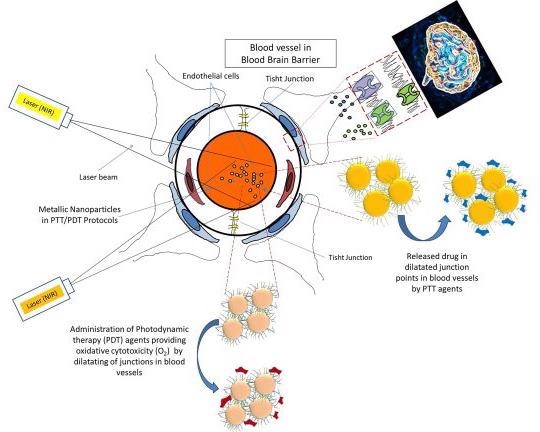Using laser light to treat cancer and other diseases is not currently considered standard practice in the clinical setting. However, new nanoparticle-based approaches show potential for enhancing existing techniques.
 Combined PDT/PTT approaches for the treatment of brain tumors. Dual function nanoparticles are used for combined PDT/PTT approaches. In PDT, the PS to produce ROS can be attached to nanoparticles and delivered to the tumor. The combination of nanoparticles and irradiated laser beam increases the permeability of the microvessels to transfer nondiffusible drugs across the vessel wall. Image Credit: Nasseri et al.
Combined PDT/PTT approaches for the treatment of brain tumors. Dual function nanoparticles are used for combined PDT/PTT approaches. In PDT, the PS to produce ROS can be attached to nanoparticles and delivered to the tumor. The combination of nanoparticles and irradiated laser beam increases the permeability of the microvessels to transfer nondiffusible drugs across the vessel wall. Image Credit: Nasseri et al.
Photothermal therapy (PTT) is a technique that converts laser light into heat that can pinpoint and destroy tumor cells. Photodynamic therapy (PDT) is another technique that uses laser light to create reactive oxygen species (ROS) like singlet oxygen, hydroxyl radicals, hydrogen peroxide and superoxide radicals which can annihilate tumor cells.
A multinational team of researchers reviews the current state of nanoparticle-enhanced PDT and PTT in Applied Physics Reviews, published by AIP Publishing, and focuses on integrating the two techniques to attain the highest level of treatment efficacy.
Researchers combined PTT or PDT with nanomaterials and applied these types of phototherapies simultaneously delivering drugs to sites in the body that are otherwise inaccessible. PTT and PDT can also be combined into a single treatment, resulting in an even more effective treatment method.
A photosensitive molecule can be attached to the surface of a nanoparticle by modifying its surface. This allows the light of a specific wavelength to be absorbed. This light is converted to heat in the PTT method, while in PDT, the light generates ROS. To be effective, PDT requires ambient oxygen to produce sufficient ROS to destroy tumor cells.
In cancer therapies using this strategy, the penetration depth of laser light into the tissues is critical in determining the therapeutic efficiency.
Masoud Mozafari, Study Author, Iran University of Medical Sciences
The shape of the beam, the intensity of the laser, the wavelength of the light, and the radius of the beam are all factors that influence the penetration depth.
Combining PDT with conventional medical treatments like chemotherapy to create photodynamic antibacterial chemotherapy is a powerful approach.
The nanoparticles can be employed to deliver antibiotics or chemotherapeutic agents to the tumor site. Antibiotics can be released to prevent infection in the treated area when light is used to generate ROS molecules in the tumor, which destroys both tumor cells and bacteria.
Other surface modifications to the nanoparticle could enable it to cross the blood-brain barrier, allowing it to treat brain tumors.
One set of studies discussed in this paper involved gold nanorods with rabies virus glycoprotein attached to their surface. The gold nanorods were able to infiltrate the blood-brain barrier and target the brain tumor as this virus naturally infects the brain. Using a laser, the nanorods were able to generate localized heat, which killed the tumor cells.
Other medical conditions that can be treated with these techniques include atherosclerosis, abscesses, scar removal, nonhealing ulcers and dental infections.
Journal Reference:
Nasseri, B., et al. (2022) Nanomaterials for photothermal and photodynamic cancer therapy. Applied Physics Reviews. doi.org/10.1063/5.0047672.